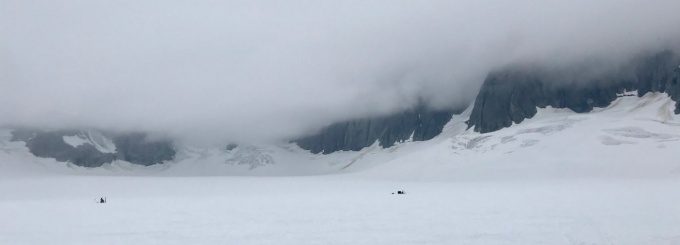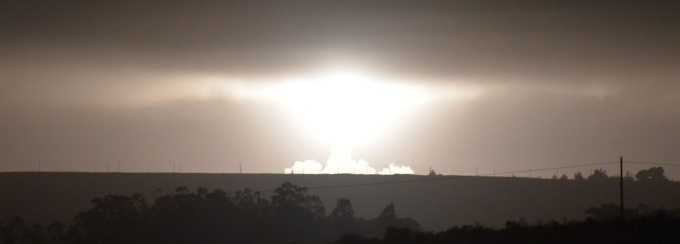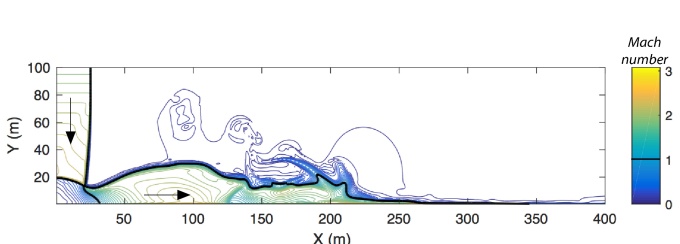Computational Geosciences

Professor Erasmus Oware, Professor Kristin Poinar, and graduate student Jeremy Stock running geophysics experiments on the Vaughan Lewis Glacier, a part of the Juneau Icefield, Alaska.
The Computational Geosciences Group at UB brings together faculty within the Department of Earth Sciences who specialize in quantitative analysis techniques. This group develops and applies numerical models and performs advanced quantitative data analyses to better understand complex Earth systems.
With a strong focus on computational approaches, the group's work leverages cutting-edge tools and methodologies to tackle pressing scientific questions across these diverse areas of Earth science.
- Beata Csatho – Ice sheet mass balance and dynamics, remote sensing of the cryosphere, laser altimetry (LiDAR sensing), geologic controls on ice flow, data fusion.
- Margarete Jadamec – Geodynamics, tectonophysics, high performance computing, high-resolution data-driven modeling of natural tectonic plate boundaries
- Chris Lowry – Physical hydrogeology and groundwater flow modeling
- Sophie Nowicki - Ice sheet modeling, climate change, ice-climate interactions. sea-level change
- Kristin Poinar – Glaciology, ice-sheet modeling, glacier hydrology
- Elizabeth Thomas - Paleoclimate dynamics; environmental change in the Arctic, Asia, and Western New York; stable isotope and organic geochemistry; proxy system modeling
- Greg A. Valentine – Volcanic risk, basaltic volcanic fields, pyroclastic deposits, volcano fluid dynamics, volcaniclastic and surface processes
Our research spans all three thematic research groups in the Department of Earth Sciences: Climate, Water & the Environment and Geohazards, Volcanoes & Geodynamics. We maintain research and computer labs in remote sensing, large-scale geodynamics, glaciology, hydrology, geophysics, volcanology and data visualization. Many of our students and research groups work with the University at Buffalo’s Center for Computational Research (CCR), which hosts and maintains UB's high-perfomance computing resources.
We run a number of research labs on campus:

Professors Beata Csatho and Tony Schenk attended the launch of NASA’s ICESat-2 satellite on September 15, 2018, 6:02 PDT. ICESat-2 measures ice sheet elevations changes to improve ice sheet models and sea level rise predictions.
- Hydrology of the Greenland Ice Sheet – how does meltwater flow on, within, and underneath the glacier and how does this affect the speed of ice flow?
- Global sea-level rise – how will melting glaciers and warming ocean temperatures change the future surface of the planet?
- Water Security – what controls the availability of water in the subsurface and how will the movement and storage of water change in the future?
- How do explosive volcanic eruptions – especially large ones – interact with their surroundings?
- What are the mechanisms behind the formation, propagation, and deposition of pyroclastic flows?
- Large-scale numerical simulations of plate tectonics and subduction- How do slab geometry, upper plate structure, and mantle rheology control three-dimensional tectonic deformation and mantle flow?
- 3D Virtual Reality for Model Exploration - How do modern 3D VR tools enhance the exploration of big data and numerial simulation output from supercomputers?

Snapshot from a numerical simulation of a falling, supersonic gas-particle mixture impacting the ground and then moving outward along the ground. Contours represent Mach numbers (ratio of flow speed to mixture sound speed), with the black contour representing Mach number of one. The transition of a falling flow to a lateral flow plays a key role in determining the dynamics of devastating pyroclastic flows during large explosive volcanic eruptions. Computations carried out at the UB Center for Computational Research. See Valentine & Sweeney (2018, Journal of Geophysical Research) for details.
Research in the Computational Geosciences group can form the basis of a PhD or MS degree in the Department of Earth Sciences. Our students benefit from the course infrastructure and collaboration with students across the Computational Masters coursework-based MS program.